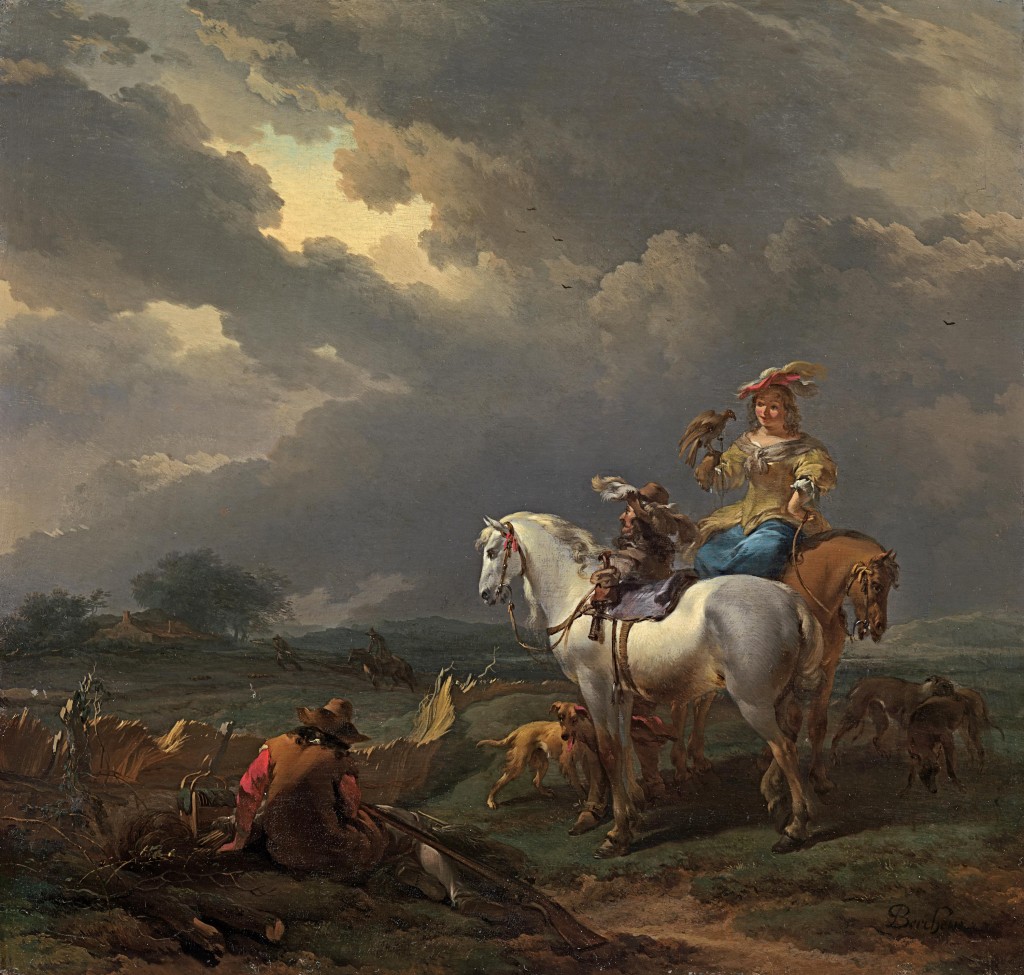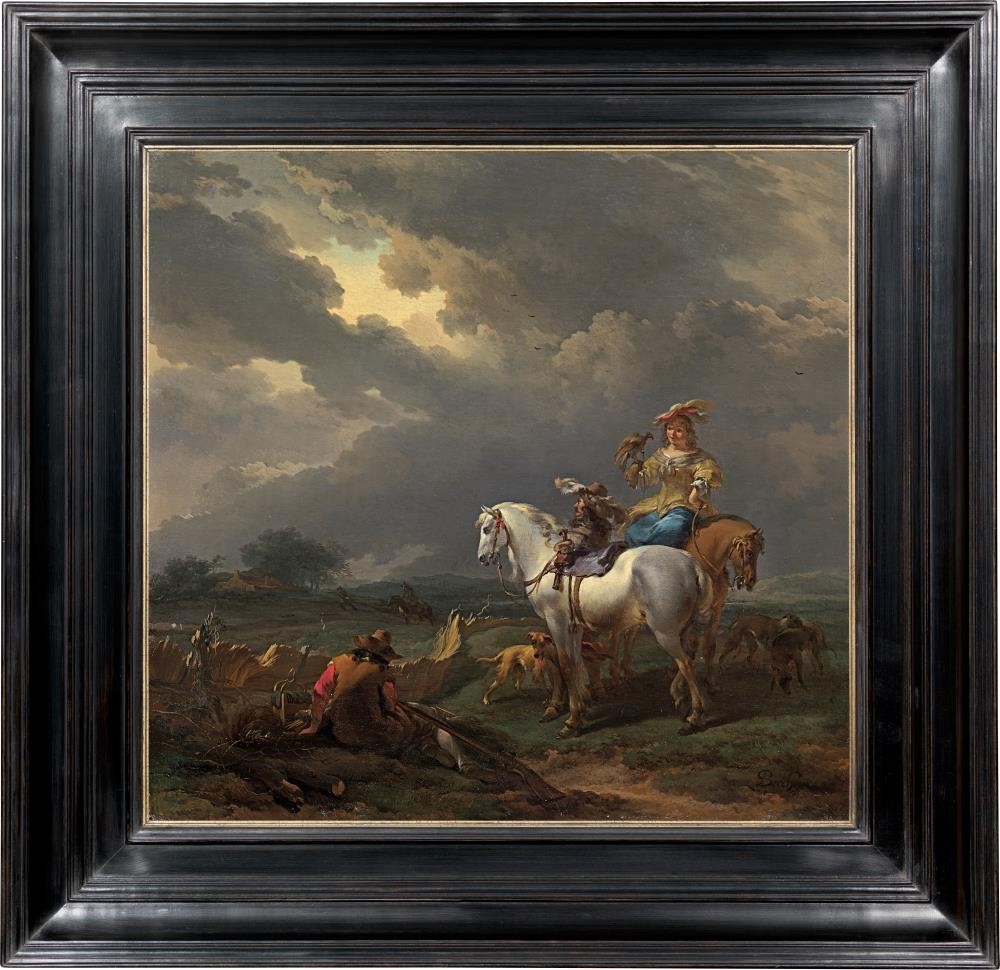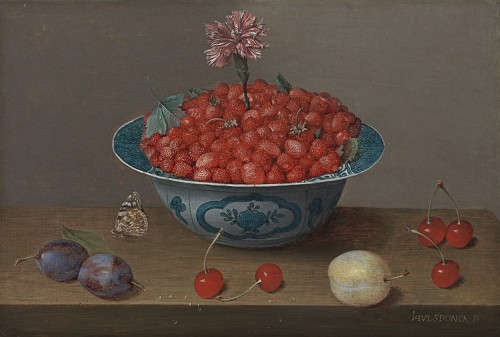NICOLAES CLAESZ. BERCHEM
Haarlem 1620 - 1683 Amsterdam
Ref: CB 221
A halt in the falcon hunt
Signed lower right: Berchem
Oil on panel: 13 ½ x 14 ¼ in / 34.3 x 36.2 cm
Frame size: 19 x 19 ½ in / 48.3 x 49.5 cm
Painted circa 1665
Provenance:
Possibly anonymous sale, Amsterdam, 16th July 1819, lot 15[1] (Dfl.16 to Gruyter) Thomas Emmerson, Esq., London; probably his sale, Phillips, London, 1st-2nd May 1829, lot 55 (with a slightly erroneous description) Acquired by John Smith in 1840 and sold by Messrs. Smith to GH Morland, 1841 Harry Vane Powlett, 4th Duke of Cleveland (1803-1891), Battle Abbey, East Sussex; his sale, Christie, Manson & Woods, London, 8th March 1902, lot 7 (155gns to Lesser) Collection of Mrs Holbrooke; her sale, Christie, Manson & Woods, London, 17th February 1939, lot 38 Vicars Brothers Ltd, 12 Old Bond Street, London, inv. no.33707 (label on the reverse)
Private collection, Europe Literature:
John Smith, A Catalogue Raisonné of the Works of the Most Eminent Dutch, Flemish, and French Painters, vol. V, London 1834, p.79, no.245 and vol. IX, Supplement, London 1842, p.599, no.19 Cornelis Hofstede de Groot, Beschreibendes und kritisches Verzeichnis der Werke der hervorragendsten holländischen Maler des XVII Jahrhunderts, vol. IX, Esslingen 1926, pp.97-98, no.163
Nicolaes Berchem was the son of the Haarlem still life painter Pieter Claesz. (c.1597-1660). He took his name, Berchem, from his father’s birthplace. Nicolaes had an extraordinarily wide artistic education, studying with his father, Jan van Goyen, Claes Moeyaert and Pieter de Grebber, among others. He became effortlessly at home in several genres, including historical, mythological and Biblical works, as well as landscapes.
In the 1650s and 60s Berchem painted a number of cavalry battles and hunting and hawking scenes, the latter influenced by the highly popular work of Philips Wouwerman (1619-1668). This painting reflects Berchem’s elegance and the delicious fluidity of his brushwork. He delights in the tones playing over the back of the magnificent grey horse, the silks of the woman’s dress and the windswept hat of the dismounted man. The party has halted in a rolling landscape beneath a stormy sky, brilliantly evoked and adding to the drama of the hunt. Such paintings appealed to the sophisticated tastes of the northern Netherlands in the second half of the seventeenth century, when Protestant austerity had long since given way to a yearning for luxury and aristocratic pursuits. Falconry was a sport of the upper class and professional Dutch falconers and their birds were famed throughout the courts of Europe[2]. The main quarry at this time would be herons, flown with peregrines, the fastest creature on earth, capable of attaining 200mph in full stoop after prey. Herons, which were hunted to eat in this period, were plentiful in the watery landscape of the Netherlands.
By the servant sitting on the ground, whose red sleeves provide a vivid colour contrast to the blue and gold dress of the lady hawking, is a gun and a cage. In the left distance, a setter points a covey of partridge while a man on foot and another on horseback draw a net over the prey. Netting was often practised in this era as an effective way of catching game birds; the cage was probably intended for the live partridge. The dogs to the right of the horses are most likely to be coursing dogs, as falconers often took dogs to course hares while hunting with the falcons[3].
When this painting was made, Berchem was living in Amsterdam, the commercial powerhouse of the Dutch Republic, a city with many wealthy collectors. The work was later in the collection of an English nobleman, Harry Vane Powlett, 4th Duke of Cleveland, KG (1803-1891). Vane Powlett served as a diplomat in Paris and Stockholm. He was MP for South Durham and then Hastings, before acceding to the Dukedom in 1864. He owned Raby Castle, Barnard Castle and 55,000 acres in Co. Durham; 25,000 acres in Shropshire and 6,000 acres in Suffolk. In 1857 Vane Powlett bought the semi-ruined Battle Abbey, near the site of the Battle of Hastings and very much in keeping with the Victorian taste for romantic medievalism.
Frederick Sargent, Harry Vane Powlett, 4th Duke of Cleveland.
National Portrait Gallery, London.
Battle Abbey, home of the 4th Duke of Cleveland, in the nineteenth century.
NICOLAES BERCHEM
Haarlem 1620 - 1683 Amsterdam
Nicolaes Berchem was the son of the Haarlem still life painter Pieter Claesz. (c.1597-1660). He took his surname, Berchem, from his father’s place of birth. Berchem had an extraordinarily extensive artistic education. He studied with his father, Jan van Goyen, Claes Moeyaert and Pieter de Grebber, among others. He painted in several genres, including historical, mythological and Biblical works, as well as landscapes, introducing new themes according to changing fashions in the art market. His impressive early Ruth and Boaz, c.1644-45 (Rijksmuseum, Amsterdam) shows the influence of the history painter de Grebber.
Berchem became a member of the Haarlem Guild of St Luke in 1642 and a member of the Reformed Church in 1645 (his parents had probably been Catholics). The following year he married Catharina, daughter of the painter-dealer Johannes Wils. Berchem began to paint pastoral, Italianate landscapes, sometimes with classical ruins, spurred by the 1638 return to Haarlem of Pieter van Laer (1599-c.1642), who had spent many years in Rome. Berchem’s fluid style and sensitive rendition of light is apparent in such works as the Italianate landscape with the ruins of Brederode Castle, 1650 (Staatliches Museum, Schwerin), which combines a Netherlandish monument with Italianate landscape and peasants. He seems not to have made the obligatory trip to study in Italy taken by many of his artist peers, but to have confected his Italianate fantasies through looking at prints and paintings. In 1650 he travelled to Bentheim in western Germany with his friend and fellow Haarlemmer Jacob van Ruisdael (1628-1682); both men sketched and painted the castle. Berchem was vinder of the Haarlem Guild of St Luke in 1656-57 and Dean in 1658-59.
In 1660 Berchem moved to Amsterdam, probably to avoid the economic recession in Haarlem. He had produced designs, engraved by Jan de Visscher, for the large map of the world published by the Amsterdam mapmaker Nicolaes Visscher in 1658. From 1665 Berchem added to his repertoire harbour views, such as the delightful Harbour view, c.1665-68 (Wadsworth Atheneum, Hartford, CT) with a grand lady, her maid and a Moorish servant. Berchem’s economic-erotic Allegory of the expansion of the city of Amsterdam, painted after 1663 (Amsterdam Museum), which may have been commissioned by Nicolaes Visscher, is characteristic of the taste of Holland’s commercial powerhouse.
In 1670 Berchem returned to Haarlem and became vinder of the Guild of St Luke. He started to paint cavalry battles and hunting scenes, emulating the highly profitable work of Philips Wouwerman (1619-1668). From c.1677 he lived once more in Amsterdam, painting the Four Seasons, c.1675, as overdoors for a house built for Herman van Swoll on the Herengracht. Berchem died in that city in 1683. Very successful in his lifetime, Berchem’s work was disseminated through prints and his paintings avidly collected in France in the eighteenth century, inspiring the work of François Boucher (1703-1770) and Jean-Honoré Fragonard (1732-1806).
[1] According to Hofstede de Groot, op. cit., vol. IX.
[2] We are very grateful to Mark Upton, falconer, artist and Director of the British Archives of Falconry, for his comments on the technicalities of falconry.
[3] Mark Upton points out that Berchem has used a certain amount of artistic licence in this painting. It would be unusual for a woman to be flying a hawk or falcon at this period. She is also holding the bird on the right wrist, which would be rare, as most people are right-handed and need their dominant hand to control the horse.

























